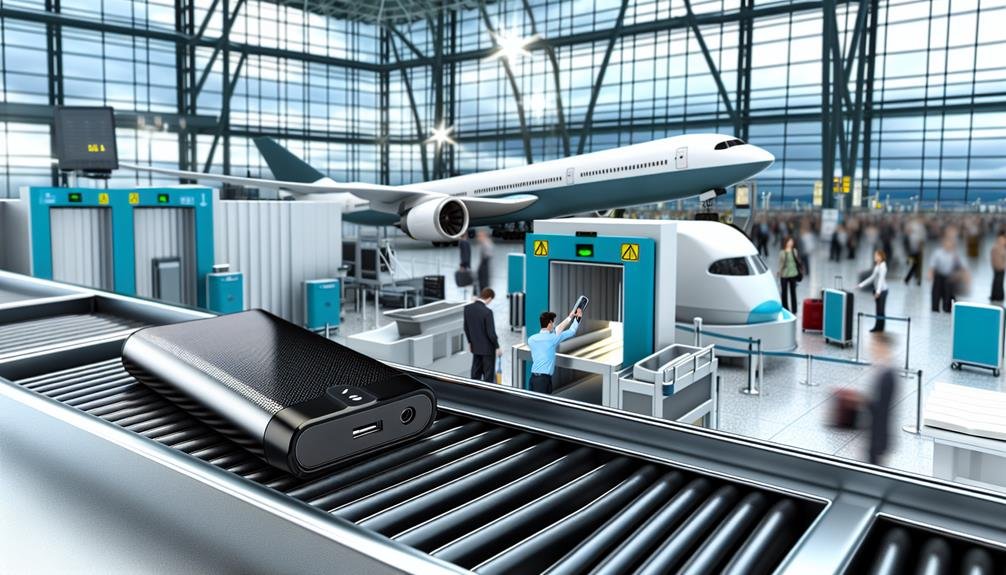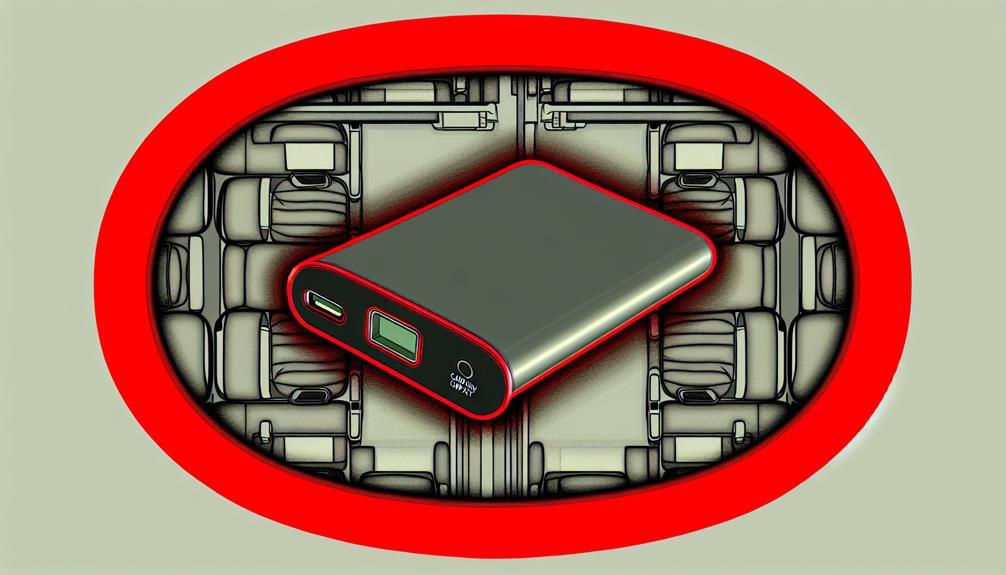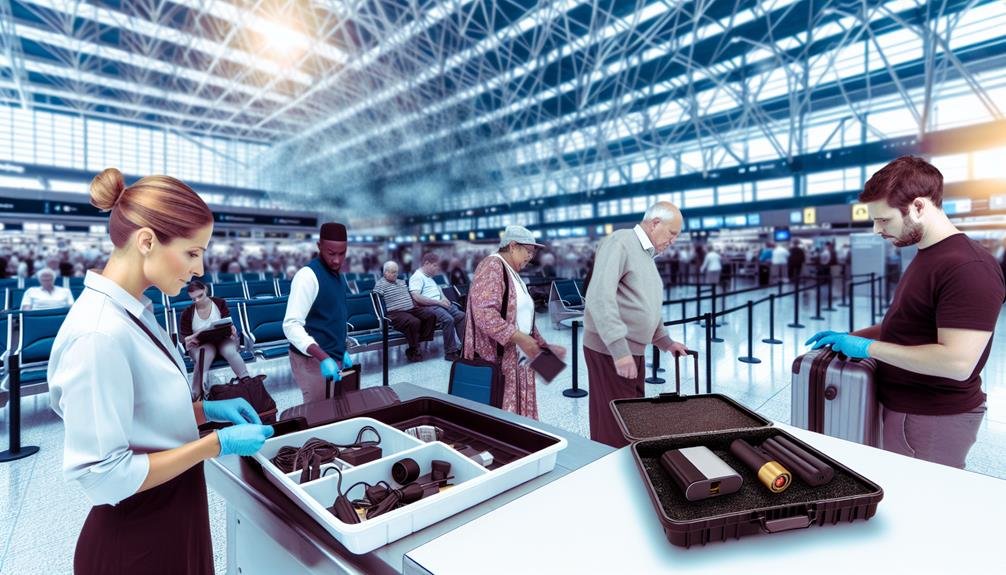Yes, you can bring power banks in your cabin baggage. TSA mandates them to be carried in your carry-on, not checked luggage, due to safety concerns with lithium batteries. Most airlines allow power banks up to 100 watt-hours without prior approval. For capacities between 100 and 160 watt-hours, you need airline consent. Anything above 160 watt-hours is generally prohibited. Always check your airline's specific regulations and make sure your power bank has proper safety certifications. Proper stowing and simple precautions can guarantee a smooth travel experience. Understanding more about power bank regulations can enhance your travel readiness notably.
Airline Regulations

When flying, it's crucial to understand that most airlines have specific regulations prohibiting power banks in checked luggage, requiring them to be carried in cabin baggage instead. This rule stems from safety concerns related to lithium batteries, which are prone to overheating and could pose fire hazards if not properly managed.
Airport security is strict about these regulations. You'll need to remove electronic devices and power banks from your bag during screening for inspection. Not only do these items need to be easily accessible, but they also must comply with the airline's capacity limits for lithium batteries. Typically, power banks with a capacity of up to 100 watt-hours are allowed without prior approval, while those between 100 and 160 watt-hours might require airline consent. Anything beyond that is generally prohibited.
Customs checks can also be a point of concern. Different countries have varying rules regarding the import and export of electronic devices powered by lithium batteries. To avoid delays and potential confiscation, familiarize yourself with the specific regulations of both your departure and destination countries. Adhering to these guidelines guarantees not only your safety but also the safety of all passengers and crew on board.
TSA and International Guidelines
When you're traveling with power banks, understanding TSA rules, international safety standards, and airline-specific regulations is vital. The TSA mandates that power banks must be carried in carry-on luggage, and each airline may have its own restrictions on battery capacity. International guidelines also vary, so it is crucial to check both the departure and destination countries' regulations to make sure compliance.
TSA Power Bank Rules
Before packing your power bank for your next flight, understanding the TSA regulations and international guidelines that govern the transport of these devices in cabin baggage is crucial. The TSA has specific rules about carrying power banks to guarantee passenger safety. To start, power banks must always be carried in your carry-on baggage and not in checked luggage due to the risk of fire.
TSA power bank restrictions stipulate that any power bank with a capacity of 100 watt-hours (Wh) or less can be carried without prior approval. If the capacity ranges between 100 Wh and 160 Wh, you can bring it onboard, but you'll need airline approval. Anything above 160 Wh is generally prohibited.
When it comes to international travel, the rules might vary slightly, but most airlines adhere to similar standards. Always check the airline regulations before flying. For example, some countries might have more stringent power bank capacity limits.
Ensuring your power bank complies with these regulations not only keeps you within the law but also enhances overall flight safety. Always remember to check the capacity marked on your power bank and verify with your airline if in doubt.
International Safety Standards
Did you know that both TSA and international aviation authorities have stringent guidelines to guarantee the safe transport of power banks in cabin baggage? These regulations are in place to prevent potential hazards associated with lithium-ion batteries, which are commonly used in power banks.
To start, power banks must have proper safety certifications, such as those from Underwriters Laboratories (UL) or other recognized testing agencies. These certifications ensure that the power banks meet specific safety standards, reducing the risk of overheating or catching fire during the flight.
Additionally, there are battery capacity restrictions you need to be aware of. For instance, the TSA and many international guidelines stipulate that power banks with a capacity of 100 watt-hours (Wh) or less are generally allowed in cabin baggage without prior approval. If your power bank's capacity ranges between 100 Wh and 160 Wh, you may need airline approval before bringing it on board. Power banks exceeding 160 Wh are typically prohibited from being carried in either cabin or checked baggage.
Airline-Specific Regulations
Understanding the airline-specific regulations for carrying power banks can be challenging, but grasping TSA and international guidelines is necessary for a hassle-free travel experience. The Transportation Security Administration (TSA) allows power banks in carry-on luggage but prohibits them in checked baggage due to fire hazards associated with lithium batteries. To comply with TSA guidelines, make sure your power bank doesn't exceed a capacity of 100 watt-hours (Wh). If your power bank is between 100Wh and 160Wh, you can carry it, but you'll need airline approval.
International guidelines can differ, so always check with your airline before traveling. Many carriers follow the International Air Transport Association (IATA) recommendations, which align closely with TSA's rules. However, some airlines may impose stricter power bank restrictions, such as limiting the number of devices you can carry or requiring them to be individually protected.
Adhering to these carry-on limitations is vital for your safety and that of other passengers. It's wise to carry documentation of your power bank's specifications and be prepared for additional screening. By following these guidelines, you'll make sure your travel is smooth and secure, avoiding potential issues at security checkpoints.
Power Bank Capacity Limits

When you're packing power banks in your cabin baggage, it's important to be mindful of the capacity limits imposed by airlines and aviation authorities. These power bank restrictions are vital for maintaining safety and compliance at airport security checkpoints. As a traveler, you need to know that most airlines limit the capacity of power banks to no more than 100 watt-hours (Wh) per device. This is roughly equivalent to 27,000 milliampere-hours (mAh) for a standard 3.7V battery.
If your power bank exceeds this limit but is under 160Wh (around 43,200mAh), you may still be allowed to carry it, but you'll likely need airline approval. It's always best to check the specific guidelines of your carrier before traveling. Remember, power banks exceeding 160Wh are generally prohibited.
Understanding these capacity limits is essential for your travel essentials. Adhering to the rules not only guarantees smooth passage through airport security but also enhances in-flight safety. Make sure to verify the capacity of your power bank, which is usually indicated on the device itself. This due diligence will help you avoid any inconveniences or confiscation of your power bank at the airport.
Safety Precautions
While following power bank capacity limits is important, taking additional safety precautions guarantees even greater security during your travels. Securing the right power bank placement is essential. Always keep your power bank in your carry-on luggage; never place it in checked baggage. This allows for quick access and immediate action if any issues arise, reducing the risk of fire hazards.
Next, follow necessary safety measures to maintain the integrity of your power bank. First, avoid exposing it to excessive heat or direct sunlight for extended periods. High temperatures can compromise the battery's safety, leading to potential malfunctions. Additionally, never use a damaged power bank. Inspect for any visible signs of wear, such as swelling, cracks, or leaks, before your trip.
Also, always use the manufacturer-recommended charger to prevent overcharging or short circuits. When not in use, keep your power bank disconnected to avoid accidental activation. It's wise to store it in a protective case to prevent physical damage during transit.
Lastly, familiarize yourself with airline-specific regulations regarding power banks. Different airlines may have varying policies, and being well-informed ensures a smooth security check process. Prioritizing these safety measures will help you travel with peace of mind.
Stowing Your Power Bank

When it comes to stowing your power bank in cabin baggage, you must adhere to proper storage guidelines, guarantee safety precautions, and comply with airline regulations. Always place your power bank in a carry-on bag, never in checked luggage, as this prevents potential fire hazards. Make sure to check your airline's specific rules regarding the allowed capacity and number of power banks.
Proper Storage Guidelines
Securing the safe storage of your power bank in cabin baggage is crucial to prevent any potential hazards during your flight. Proper organization and secure handling are key to maintaining safety. First, consider the storage options available in your carry-on bag. Place your power bank in a designated pocket to avoid contact with other electronic devices that might cause short circuits.
When it comes to safety measures, always safeguard your power bank in a protective case. This not only prevents accidental activation but also shields against physical damage. Additionally, make sure the power bank is turned off and stored away from any metallic objects to reduce the risk of sparking.
Here's a quick guide to help you store your power bank properly:
| Step | Action | Notes |
|---|---|---|
| 1 | Use a designated pocket | Prevents contact with other electronics |
| 2 | Place in a protective case | Shields against damage and accidental use |
| 3 | Turn off the power bank | Guarantees it's not accidentally activated |
| 4 | Keep away from metallic objects | Lessens risk of sparking |
| 5 | Regularly check the power bank for damage | Early detection of issues guarantees safety |
Safety Precautions
Following strict safety measures is important when stowing your power bank to minimize any risks during your flight. To begin with, always make sure your power bank is placed in your cabin storage, not in the checked luggage. This step is crucial for battery safety, as the cabin environment is more controlled, and crew members can respond promptly in case of an issue.
Make certain your power bank is turned off and, if possible, stored in a protective case to prevent accidental activation or damage. It's vital to avoid any contact with metal objects, as this can lead to short circuits. Placing the power bank in a separate pocket or compartment within your carry-on bag can help minimize such risks.
Additionally, keep an eye on the temperature. Power banks should not be exposed to extreme heat or cold, as these conditions can compromise battery safety. If your power bank feels unusually warm, inform a flight attendant immediately. By following these guidelines, you can ensure that your power bank is stowed safely, protecting you and your fellow passengers during the flight. By adhering to these practices, you'll contribute to a safer travel environment for everyone on board.
Airline Regulations
Each airline has specific regulations for stowing power banks, so it's important to familiarize yourself with these rules before you travel. Knowing the battery capacity and airline restrictions is crucial to guarantee compliance and safety. Generally, power banks must be carried in your cabin baggage and not in checked luggage. This is because of the potential fire risk posed by lithium-ion batteries.
Battery Capacity Limits and Airline Restrictions
| Airline | Max Battery Capacity Allowed | Restrictions |
|---|---|---|
| Airline A | 100Wh | Max 2 spare batteries in carry-on |
| Airline B | 160Wh | Requires airline approval |
| Airline C | 100Wh | No more than 20,000mAh per device |
Understanding safety regulations and international travel restrictions is essential for a hassle-free experience. Most airlines allow power banks up to 100Wh without prior approval. For capacities between 100Wh and 160Wh, you generally need to seek permission from the airline. Batteries exceeding 160Wh are typically prohibited.
Always check the latest guidelines on the airline's website before your trip. Adhering to these rules ensures not only your safety but also the safety of other passengers. By being well-prepared, you can avoid unnecessary delays and complications during your travels.
Special Airline Rules
Airlines often impose specific regulations on carrying power banks in cabin baggage to guarantee passenger safety and compliance with international aviation standards. These rules can vary significantly between airlines, so it's vital to check with your specific carrier before traveling. Some airlines may have exceptions for certain types or capacities of power banks, allowing them only if they meet specific criteria.
Government restrictions also play a pivotal role in shaping these rules. For instance, many aviation authorities mandate that power banks exceeding a particular watt-hour (Wh) rating be declared and approved before boarding. The common threshold is typically around 100Wh, but this can vary, and some airlines might allow higher ratings under strict conditions.
Additionally, most airlines require that power banks be carried in hand luggage and not checked baggage. This is because power banks contain lithium-ion batteries, which pose a fire risk if damaged or improperly stored. Ensuring they are in the cabin allows crew members to address any potential issues promptly. Remember, adhering to these regulations not only significantly enhances your safety but also that of your fellow passengers. Always double-check the specific rules of the airline you are flying with.
Travel Tips and Best Practices

Securing a smooth journey with your power bank involves understanding key travel tips and best practices to follow. First, always check the capacity of your portable chargers. Most airlines allow power banks up to 100Wh (watt-hours) in cabin baggage without special permissions. If your device exceeds this, you may need airline approval. Always confirm these details with your carrier to avoid any surprises at security.
Next, make sure your charging devices are easily accessible. Pack them in your carry-on, not checked luggage, as lithium-ion batteries pose a fire risk when stored in the cargo hold. It's important to keep your power bank in its original packaging or a protective case to prevent damage.
To avoid potential issues, refrain from using your portable chargers during takeoff and landing. Some airlines have specific rules about this, and compliance guarantees everyone's safety. Additionally, carry the necessary charging cables and adapters to prevent any inconvenience during your journey.
Lastly, be mindful of your power bank's charge level. Fully charged devices are less likely to cause problems. By following these best practices, you can enjoy a hassle-free travel experience while keeping your essential electronics powered up.
Frequently Asked Questions
Can I Charge My Devices Using the Power Bank During the Flight?
Imagine your devices as thirsty camels in a desert. Yes, you can charge them using a power bank during the flight. Just follow charging etiquette and prioritize battery safety to guarantee everyone's safe and happy journey.
Are There Any Brand Restrictions for Power Banks?
Yes, there are brand restrictions due to safety concerns. Confirm your power bank is compatible with airlines' regulations. Check the airline's guidelines to verify if your power bank meets their safety and brand requirements.
What Should I Do if My Power Bank Gets Damaged During the Flight?
If your power bank gets damaged during the flight, immediately alert the flight crew. Follow stringent safety precautions to prevent hazards. After landing, initiate the compensation process with the airline for potential reimbursement and resolution.
Can I Bring Multiple Power Banks in My Cabin Baggage?
You can bring multiple power banks in your cabin baggage, but check power bank regulations first. Confirm each meets safety precautions, like proper watt-hour limits, to safely charge devices without issues during your flight.
How Can I Check the Watt-Hour Rating of My Power Bank?
Did you know 80% of travelers use power banks? To check the watt-hour rating, look on the label or manual. Power bank regulations and airplane charging restrictions often limit it to 100Wh. Stay informed for safe travels!



